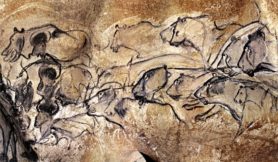November
“Two Animals One Line” – Tamalone van den Eijnden
As part of the Transmission in Motion Seminar 2017/2018 Nicholas Salazar Sutil gave a lecture on “How to get a Wall to Dance.” His speech was based on the objects of limestone, caves and cave paintings. However, while speaking of these objects of the Palaeolithic age, often also referred to as ‘prehistory,’[1] he was simultaneously touching upon topics of cutting-edge research in the life-sciences, among others, the fluid boundaries between different animals.
As one important characteristic of the Palaeolithic cave painting Salazar identified how lines that shape the body of one animal fluidly transcend into the body of another animal. He saw this as indicative of a worldview where different animal are embodiments of an ever-continuing process of life. A similar idea also is to be found in Clottes’ writing, where he identifies “fluidity” as an “attitude of mind” which sees humans and animals as interconnected and the idea, that we all share a common past[2].
Such ideas are radically different from the biblical idea that: “God made the beasts of the earth after their kind, and the cattle after their kind, and everything that creeps on the ground after its kind,”[3] or modern western scientific thinking that categorizes different life forms into species and races. However, today we can observe a reverse tendency, a return to the acknowledgement of the interconnectivity of life. For example, animals, equally to ‘human-animals,’ are constituted by DNA, we are made out of the same building blocks of life. Also in terms of biological complexity, humans are less unique as it might have been assumed. Simultaneously, we may observe today a greater willingness to cross over boundaries between humans and other animals, especially in the realm of art. Yesterday, for example, I have visited an Ethics Panel Performance where the Artists Maja Smrekar presented her work Hybrid Family, of which she states “The biopolitical statement of the project is about becoming-animal during a process through which I transcendent myself into a surrogate mother of the dog.” There are also examples, where hybridity is incorporated within the same body, for example, Charles Vacanti’s laboratory mouse that had something that looked like a human ear on its bag or Eduardo Kac’s glowing rabbit Alba, whose fluoresces green was produced by a jellyfish gene.

the Rabbit Alba by Eduardo Kac

Hybrid Family by Maja Smrekar

the Vacanti mouse, by Charles Vacanti
So does science allow us to return to a worldview, which brings us back to a romantic closeness to and interconnectivity with nature? Based on Yuval Noah Harari’s reflection on animism, I would argue that this is not the case. According to him, “anthropological and archaeological evidence indicates that archaic hunter-gatherers were probably animists,” meaning that everything was equally endowed with life and spirits[4]. Thus, there was a “ceaseless negotiation between all concerned beings. People talked with animals, trees and stones, as well as with fairies, demons and ghosts”[5]. After the agricultural revolution and the emergence of theists religions, people no longer talked to non-human entities. Nature was silenced and from now on the gods served as the mediators between humans and the world[6]. Finally, “during the Scientific Revolution humankind silenced the gods too”[7]. Consequently, instead of asking nature or the gods to about permission scientists nowadays study for example genes to increase the diary production “and the genes don’t ask for anything in return”[8]. Thus, although (and maybe because) we nowadays have the technical capabilities to cross over to other animals, by no means it can be compared to a worldview as suggested by the cave paintings since experiments at the biological level remain mostly highly anthropocentric.
In conclusion, Salazar addressed many topics which are highly relevant outside of the interest of caves. This makes his research highly relevant. His choice to focus on caves instead of genetic manipulation allowed him to give a very different perspective on these matters. Thus, his argument can be seen as a critique of the current developments in the life sciences that silences other voices.
[1] See for example the Wikipedia entry on Paleolithic.
[2] Jean Clottes, “Why Did They Draw in Those Caves?”, Time and Mind, 6, no. 1 (2013), 9.
[4]Yuval Noah Harari, Homo Deus (London: Vintage. 2017), 88.
[5] Harari, 88.
[6] Harari, 107.
[7] Harari, 113.
[8] Harari, 113.
Bibliography
- Harari, Yuval Noah. Homo Deus. London: Vintage. (2017).
- Jean Clottes. “Why Did They Draw in Those Caves?” Time and Mind, 6, no. 1 (2013).


